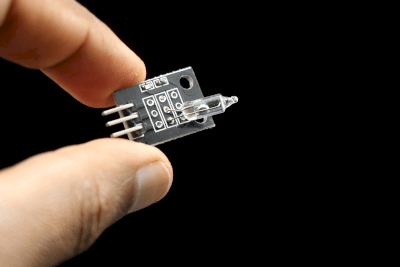What Is a Tilt Sensor?

A tilt sensor is a sensor that measures the inclination (tilt angle or slope) of an object.
Also called angle sensor, slope sensor, tilt sensor, or inclinometer. It is based on gravity and is installed horizontally to measure inclination.
Even when measuring in a vibrating environment, tilt sensors with additional electronics to adjust input and output can provide reliable measurement results due to the damping effect. Highly shock-resistant tilt sensors can measure acceleration in moving machinery, vehicles, aircraft, and construction equipment.
Uses of Tilt Sensors
Tilt sensors are used in a variety of uses, of which tilt adjustment is required.
- Automotive Headlights
Automatic adjustment of headlight beam angle. - Building Structure
Detects tilting and other deterioration of building structures. - Work Truck
Detects inclination of lifts, cranes, etc. - Transportation Equipment
Detects tilting of transportation equipment in automobiles and railcars to prevent them from tipping over. - Workbench
Maintain level forestry and construction equipment loading docks. - Correction of Industrial Machinery, Optical Devices and Inspection Equipment
Corrects tilting of aircraft and construction equipment interiors, electronic balances, etc. - Smart Phone
Automatic screen rotation.
Principle of Tilt Sensors
Tilt sensors are installed so that they are horizontal in the direction of measurement. There are two types of principles of tilt sensors: electrolytic and MEMS (Micro-Electro-Mechanical Systems). The MEMS type is the most common in terms of accuracy and response time.
1. Electrolyte Type (Capacitance Type)
Considering the fact that the surface of the liquid is horizontal, the tilt is detected as the amount of change in capacitance from the tilt of the liquid. A pair of electrodes is placed on the bottom of the device, and conductive liquid is enclosed in a cavity inside the device. When voltage is applied between the electrodes, an electric field is formed.
As the liquid flows, the electric field changes and the internal resistance of the circuit changes, and the angle is measured by measuring the amount of this change. However, care must be taken because the response time is relatively slow and the liquid level is easily affected by vibration.
2. MEMS Type
This method utilizes micro-electro-mechanical system technology. The inclination is measured by the deflection of the site due to gravity. Two pairs of fixed and movable electrodes are arranged.
The angle is measured by measuring the change in electrostatic capacitance from the change in the positional relationship of the electrodes due to inclination, and a low-pass filter is used to attenuate shocks to reduce errors.
Other Information on Tilt Sensor
Tilt Sensor and Acceleration Sensor
A tilt sensor detects the inclination (tilt angle or slope) of an object. There are also tilt sensors and acceleration sensors that can measure inclination.
1. Inclination Sensor
The sensor output itself contains the tilt angle information. Because of its low frequency fluctuation, the sensor is effective for measuring the tilt angle in slow motion or in a stationary state.
Since the tilt sensor detects tilting, it is effective in preventing cranes and construction vehicles, such as construction equipment, from tipping over.
2. Accelerometer
This sensor detects acceleration applied to an object. It detects not only the direction of gravity but also the forward/backward and left/right directions of motion. Compared to tilt sensors, these sensors have a wider frequency bandwidth and can measure fast movements.
Acceleration sensors are used in applications that change the vertical and horizontal display of a smartphone to match the environment in which it is used.